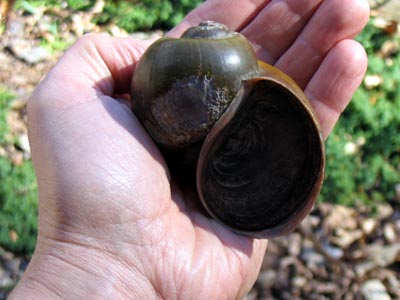| 9/13/2005
Blackshear, Georgia - Itís just the kind of tourism Georgia
doesnít need. Recent surveys conducted by the
Georgia
Department of Natural Resources, Wildlife Resources Division (WRD) have
documented breeding populations of a large, invasive species of snail
native to South America. During a recent search, WRD biologists removed 79
of the channeled apple snails and 151
egg masses from a pond in Pierce
County in a span of less than four hours. |

Photo by Georgia DNR |
A live snail found near the Alabaha River in Pierce County in early 2005
was identified as a channeled apple snail. The specimen was the first of
its kind discovered in the state. Since then, live apple snails and eggs
have been found in several ponds and streams in the Alabaha River system, a
tributary of the Satilla River in Southeast Georgia.
These snails have a voracious appetite for aquatic plants, which many
native species depend on for foraging and shelter, said WRD Wildlife
Biologist Brett Albanese.
Shells of channeled apple snails can reach a width of more than two inches
and a height of three inches, and are yellowish to brown in color.
Channeled apple snails have established populations in at least six Florida
counties, and breeding populations of the species also exist in Texas,
California and Hawaii.
Initial findings of the snails in Georgia raised speculation that the
specimens might have been aquarium pets released into the wild, but the
subsequent discovery of a large population in a popular fishing spot may
indicate otherwise.
We now suspect that these snails may have hitched a ride into Georgia on a
fishing boat that had been in Florida waters, where the apple snail has
also been introduced, said WRD Fisheries Technician Chad Sexton.
The discoveries were of particular interest to biologists because of the
invasive nature of the species. An array of problems can arise when pet
owners or fishermen introduce non-native species into Georgiaís waters.
Non-native or nuisance species can be spread when anglers release live bait
into the water or move between water bodies without cleaning boats and
trailers.
The WRD Fisheries Management Section and the WRD Nongame Wildlife and
Natural Heritage Section have been working to monitor the spread of apple
snails in the Alabaha River system. They are experimenting with trapping
and manually harvesting adult snails from ponds and streams and manually
removing the egg masses from trees.
Although the track record for eradicating non-native species is not
promising, biologists hope that they can halt or slow the spread of these
snails in South Georgia, Albanese said. One reason for optimism is that we
can target two life stages of the snails both the eggs and the adults for
removal.
Conservation agencies nationwide are working to stop the spread of
non-native aquatic plants and animals, citing concerns about the
potentially harmful impact to native species.
The wrong organism in the wrong place can eat or out-compete native
species, which can have serious impacts on an entire aquatic community.
Invaders can also spread non-native diseases, Sexton said.
For more information about aquatic nuisance species, visit
www.protectyourwaters.net or
www.gofishgeorgia.com. Additional information on identifying apple
snails is available at
www.applesnail.net. Georgia residents who think they have found an
apple snail should collect it, photograph it and provide detailed locality
information to WRD Fisheries Management in Waycross at (912) 285-6094, or
WRD Headquarters at (770) 918-6400. Citizens should also be on the lookout
for the apple snailís bright pink eggs, which are laid on trees and shrubs
above the waterline.
|